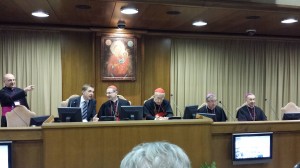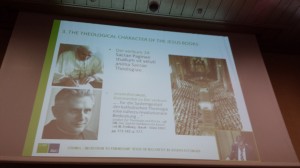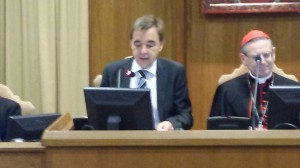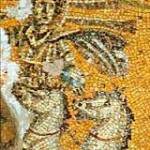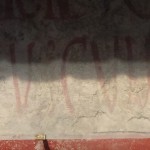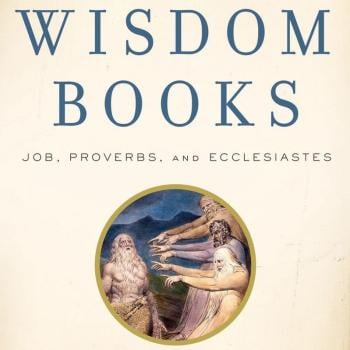The Conference sponsored by the Ratzinger Foundation (i.e. Pope Benedict) was designed to focus on the historical Jesus, with more particular focus on Pope Benedict’s three million selling books on Jesus of Nazareth (the last of which was on the Infancy Narratives in Lk. 1-2 and Mt. 1-2). Since I have already reviewed in detail these three books on this blog some time ago (the first book came out in 2005,but I reviewed them more recently), I will let you find and read those reviews. The reviews were quite positive, indeed the reviews of these books world-wide has been quite positive by scholars, many of whom were surprised Protestants. Joseph Ratzinger is a fine German scholar, in particular a theologian. He is the first scholarly Pope in a very long time. I would liken his work on the historical Jesus to that of another Continental Catholic theologian— Edward Schillebeeckx who wrote some excellent books on Jesus.
There were quite a few excellent papers at the conference. On Saturday morning there was an excellent summary paper by Thomas Soding from the University of Bochum, Germany analyzing ‘The Jesus of Nazareth’ by Joseph Ratzinger. Here are pictures of the Old Synod Hall with Soding lecturing and one of Soding’s powerpoints a picture of Ratzinger as a young theological student, before he helped shape the theological statements at Vatican II.
The papers given on the previous two days of the conference were mostly by Continental Catholic scholars, some of them quite excellent, and too many of them (for my language skills) in rapid fire Italian. The two previous sessions were held at Lateran University in a beautiful Aula or lecture hall.
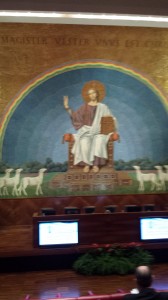
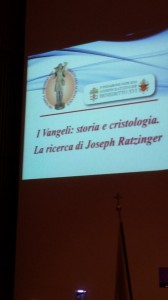

Here is Richard Burridge of Kings College London, who won the Ratzinger prize, giving his paper on “The Greco-Roman Biographies and the Gospel Literary Genre”
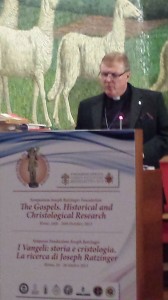
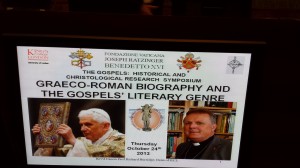
What this paper did was compare the Christological work of Benedict with Richard’s own research on the Gospels as ancient biographies.
And here is Richard receiving his prize certificate from Pope Francis, later at the audience on Saturday.
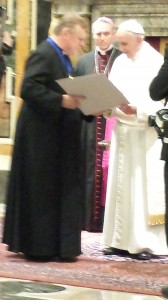
There were other interesting papers by Juan Chapa of Navarra, Spain on the contribution of papyrology to the interpretation of the Gospels, by our host and new friend Bernardo Estrada of the Pontifical University recounting the historical of research on Jesus from Reimarus to Ratzinger, there was an excellent paper by Richard Bauckham on Luke’s Infancy Accounts as Oral History, focusing particularly on the presentation and purification scene in the Temple, which he demonstrated was perfectly historically plausible, and that much of the objection to the scene has been based on not knowing the OT background well enough to the practices involved. On Oct. 25th (Friday) Klaus Berger from the University of Heidelberg (who must be closing in on 80 or so by now) gave a paper on the Reliability of the Gospels, and how the criteria for deciding authenticity have essentially failed.
This was followed by a rather snarky and deliberately provocative paper by John Meir of Notre Dame (the only North American Catholic scholar presenting at the conference) arguing that the Parable of the Good Samaritan is an example of Lukan theology and does not go back to the historical Jesus, trying to claim that Pope Benedict’s books supported the bifurcation of history on the one hand and Christology on the other. They do not. What I found most unhelpful about this paper, was the idea that since Luke is in the canon, then the theology of Luke is canonical, and the historical questions don’t impinge on the value of his ‘theology’. This completely ignores the fact that there was no canon before the 4th century A.D. and no canonical theology. The Christians of the first four centuries believed, as did later Christians that Jesus told that parable, and that that was especially why it was of value. To this I would just add when it comes to a historical religion— nothing can be theologically true that is historically false. In this case, Luke preserved that parable because he believed it came from Jesus and reflected Jesus’ thought, however much Luke told the parable in his own diction. Here’s a picture of this paper being delivered.
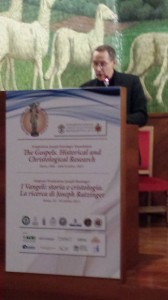 There were other fine papers by Craig Evans on the Death of Jesus, and Stan Porter on the contribution of extra-Biblical sources to the discussion of the historical Jesus.
There were other fine papers by Craig Evans on the Death of Jesus, and Stan Porter on the contribution of extra-Biblical sources to the discussion of the historical Jesus.
I also gave my paper on Friday morning and had to settle for just giving a summary abstract, due to time constraints. Here is the abstract:
JESUS THE SAGE AND HIS PROVOCATIVE PARABLES
Dr. Ben Witherington, III
Doctoral Faculty– Asbury Theological Seminary, Kentucky
and St. Andrews University, Scotland
SUMMARY– In the last 30 years of New Testament scholarship about the historical Jesus and his teachings and ministry, one of the most fruitful avenues of study that has shed increasing light on the actual historical character of Jesus and his ministry is evaluating Jesus as a sage, a conveyor of godly wisdom, and evaluating his parables, aphorisms, and riddles as early Jewish wisdom speech. This paper further explores this trajectory of New Testament scholarship, focusing both on the issue of the character of sapiential language and how it should and should not be evaluated, and the unique use of that language by Jesus to talk about God’s coming eschatological Dominion or Kingdom. While previous Jewish sages had told parables about God’s eternal kingship or reign, before Jesus’ time, apparently none had used wisdom speech to describe God’s current in-breaking eschatological work of salvation among God’s people. And yet Jesus offers up a sort of revelatory wisdom that is not self-evident. He is not drawing wisdom from the analysis of nature or human nature (like e.g. the writers of Proverbs), but rather from God’s special revelation about his salvific purposes for humankind. Jesus then was an apocalyptic sage, much like Daniel, offering a wisdom that God had to reveal or else it could not be known, even through detailed study of nature and human nature.
Focusing on Mark 4 and the parable of the sower, this paper reveals how ancient parables work, and what they tell us about Jesus’ teaching ministry, and indeed his own intentions and self-understanding. In the words of Rudolph Bultmann, Jesus is the revealer of saving wisdom, and ultimately what he reveals is himself—he is both the conveyor of God’s Wisdom, and the substance of God’s Wisdom, come in person. Put another way, Jesus views himself as not just the means of God’s eschatological salvation, but the substance of that salvation as well. The narrative in Mark 4 helps us better understand both the wisdom of Jesus, and Jesus as Wisdom—the revelation of God’s mind, character, person. In particular this paper suggests that Jesus’s own self understanding was deeply indebted to Dan. 7.13-14, where a perpetual kingdom ruled by one person who is in fact the object of worship may be contrasted with the dynastic Davidic kingdom promised in 2 Sam. 7.14. Perhaps there was a good reason why Jesus deliberately chose to speak of the Kingdom of God, rather than the Kingdom of Israel, and of being Son of Man, rather than of being Son of David. The reason was, Jesus had intended all along a more inclusive nature to his ministry and mission—not just to the lost sheep of Israel, but to the nations as well, not just to fulfill Jewish messianic hopes, but more broadly to fulfill human needs for salvation and wisdom for living.
———


